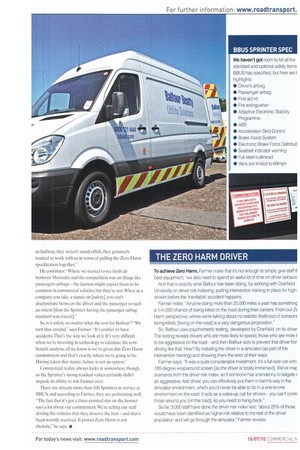THE ZERO HARM DRIVER
Page 37

If you've noticed an error in this article please click here to report it so we can fix it.
To achieve Zero Harm, Farmer notes that is not enough to simply give staff tt best equipment, we also need to spend an awful lot of time on driver behavio
And that is exactly what Balfour has been doing, by working with Cranfield University on driver risk indexing, putting intervention training in place for highdrivers before the 'inevitable' accident happens.
Farmer notes: "Anyone doing more than 25,000 miles a year has something a 1-in-250 chance of being killed on the road during their careers. From our Zc Harm perspective, where we're talking about no realistic likelihood of someom being killed, [being on the road] is a very dangerous proposition."
So, Balfour uses psychometric testing, developed by Cranfield, on its driver The testing reveals drivers who are more likely to speed, those who are more Ii to be aggressive on the road and then Balfour acts to prevent that driver tor driving like that, How? By installing the driver in a simulator (as part of the intervention training) and showing them the error of their ways.
Farmer says: "It was a quite considerable investment. It's a full-size car with 180-degree wraparound screen [so the driver is totally immersed]. We've mar scenarios from the driver risk index, so if someone has a tendency to tailgate an aggressive, fast driver, you can effectively put them in harm's way in the simulator environment, which you'd never be able to do in a one-to-one environment on the road. It acts as a wake-up call for drivers you can cones those around you [on the road], so you need to hang back.'
So far, 3.000 staff have done the driver risk index test: "about 25% of those would have been identified as higher-risk relative to the rest of the driver population and will go through the simulator," Farmer reveals.
































































































































